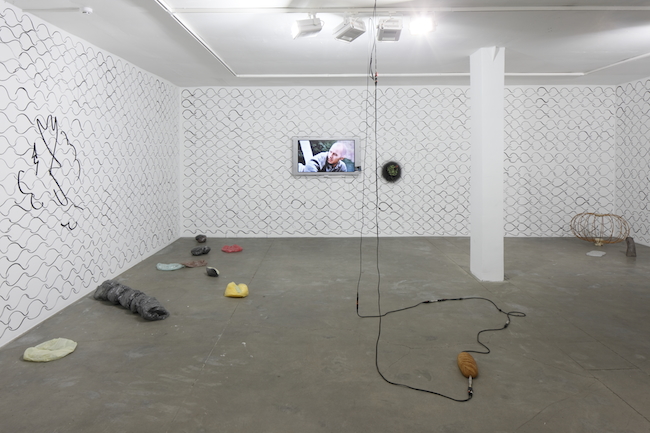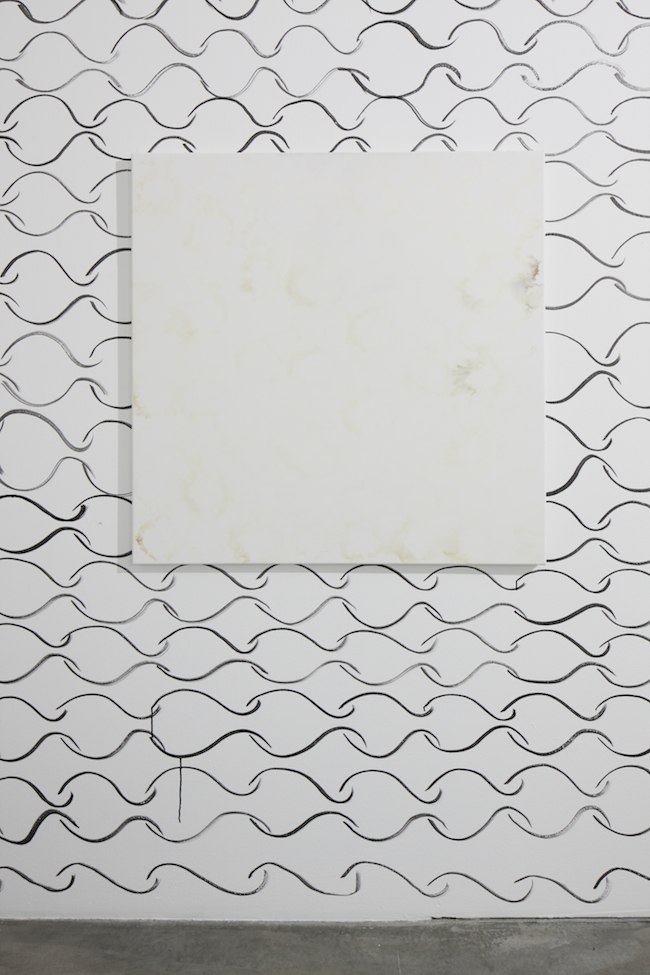
From poetry to mumble. Conversation as objects is space
Review: “Exit, Stuttering & Nebula” at kim? Contemporary Art Centre
Weronika Trojańska*
15/01/2016
EXIT, STUTTERIG & NEBULA
kim? Contemporary Art Centre, Riga
Through January 24, 2016
The title of the current exhibition showing at the kim? Contemporary Art Centre, “Exit, Stuttering & Nebula”, sounds as abstract and enigmatic as the show appears to the viewer when he or she encounters it for the first time. Situated on the ground floor and just inside the door to the art center, the show doesn’t make it easy for the visitor to figure out what is really going on; the press release is just as mystifying: “In the beginning, there were sentences which could not possibly not be misread” – it states. “...there were...” – so, what is left then?
It seems as if the curator of the show, Kaspars Groševs, has put together a handful of enigmatic puzzles in order to create a peculiar riddle. Its pieces, made by seven different international artists, have been spread out throughout the gallery. An element that appears to tie them all together is a wall pattern painted by Groševs himself (he also happens to be an artist and art writer). The shape of this pattern can be also found in some of his earlier works, such as “Without a thread a nebula unravels” (2014-15). In this context, the “Exit, Stuttering & Nebula” show could be also seen as operating on a similar basis to his practice as an artist. The nebula pattern resembles a knitted plait or basket-weave that braces all of the elements, but it also could be a net or chain-link fence that separates the things inside it from the surrounding environment. It trails along all of the walls, spreading in all directions – it is very visible and organizes the space.
Exit, Stuttering & Nebula installation view at kim?, 2015. Image courtesy the artists and kim? Contemporary Art Centre. Photo: Ansis Starks
The first work one notices is the graffiti on the front window, made by Swedish artist Henning Lundkvist. He has also drawn similar gnarled black lines on the opposite wall. They look familiar; everyone has seen these kinds of shapes covering street buildings and walls around the city. Lundkvist's tags, made on top of Groševs’ nebula pattern, signify his name and mark the territory as his – much in the same way as paintings made by graffiti artists do in public spaces. The difference, however, lies in the fact that by incorporating these ambiguous signs into the gallery environment, he has given them not only his own authorship, but he has also transformed them into artifacts. Abstract signs have been placed somewhere between letters and drawings. Drawing is a language as well, but it requires different methods of reading in order to understand it. Like the language of painting, drawing often operates in metaphors that don't always allow us to see what we want to.
Vivienne Griffin. All these questions become riddles as soon as reflection upon them becomes serious, 2015. Exit, Stuttering & Nebula installation view at kim?, 2015. Image courtesy the artist and kim? Contemporary Art Centre. Photo: Ansis Starks
Exit, Stuttering & Nebula installation view at kim?, 2015. Image courtesy the artists and kim? Contemporary Art Centre. Photo: Ansis Starks
“All these questions become riddles as soon as reflection upon them becomes serious” is the title of a 2015 work by the Irish artist Vivienne Griffin. Her cut-out blinds look like minimalist monochrome paintings; initiating a timid crosstalk, they resonate with the wall piece. The process of covering and uncovering makes them both functional and non-functional items. Similarly, the Latvian-based artist Īrisa Erbse also reflects the nebula pattern. Her motif – dissolved on the canvas in all kinds of household chemicals – becomes blurry and disappears gradually, like in a fog.
Henning Lundkvist. Tag, 2015. Exit, Stuttering & Nebula installation view at kim?, 2015. Image courtesy the artist and kim? Contemporary Art Centre. Photo: Ansis Starks
Below, on the floor, three weird sculptural objects have been placed – works by the Finish artist Mikko Kuorinki. “Objects described to a wicker weaver, a stone carver and a potter” (2015) emerged from something that is invisible – language. They look like weird specimens from an anthropological museum; imaginary handicrafts left by a fictional tribe, and called “words”. They were produced by Latvian craftsmen based on descriptions given by the artist. The instructions themselves are not visible to the viewer, but knowing Kuorinki’s poetic touch, the executions of his given specifications could have been based on a poem or lyric line from a song.
Exit, Stuttering & Nebula installation view at kim?, 2015. Image courtesy the artists and kim? Contemporary Art Centre. Photo: Ansis Starks
Īrisa Erbse. Nebula, 2015. Exit, Stuttering & Nebula installation view at kim?, 2015. Image courtesy the artist and kim? Contemporary Art Centre. Photo: Ansis Starks
The aesthetic of an underground music video is present in a work by Irish artist Eoghan Ryan. Footage of him dancing to strange choreography in front of a window which in the dark acts like a mirror reflecting each movement, has been intertwined with more detailed close-ups of different items and parts of the body, all to the accompanying sound of his skype conversations with his parents. This assemblage of bizarre logic and thought connections brings to mind images of Harmony Korine or Mark Leckey. “Are you trying to make me say the word?” (2015), presented on a glossy HD screen with a family photo mounted in one corner, is, as its title suggests, about communication – a futile attempt at conversation which leads nowhere.
The absurdity of objects and actions, and their attempts at performing, are particularly visible in works by Inga Ģibiete and Frank Boyd. Ģibiete’s “Unfinished set 3” (2015) is literally a collection of colorful plastic bags sewn together in various abstract forms, while Boyd’s installation – suspended between the ceiling and the floor – consists of electric wires coming together to form a loaf of bread. According to the exhibit's text, Frank Boyd “allows emptiness to resound in electric idleness”. Does the bread presented here have a symbolic value or, on the contrary, does it have no meaning at all?
Maybe this whole narrative is a translation of an odd Dadaistic poem? It could be anything. It seems to be a point placed in the center of the room, where all of the conversations that come from the artworks cross.
Inga Ģibiete. Unfinished set 3, 2015. Exit, Stuttering & Nebula installation view at kim?, 2015. Image courtesy the artist and kim? Contemporary Art Centre. Photo: Ansis Starks
Inga Ģibiete. Unfinished set 3, 2015. Exit, Stuttering & Nebula installation view at kim?, 2015. Image courtesy the artist and kim? Contemporary Art Centre. Photo: Ansis Starks
The meanings of the presented works are not of such importance in themselves. They become the words with which to communicate in this particular environment. Each of the selected artists' works, in some way, using words and language, either recite or stutter, but the sentences they have used in this exhibition have taken on different forms with which to manifest their physical presence in the space. They could be spoken intentionally, or be located on the tip of the tongue, waiting forever to be pronounced; nevertheless, all of them are able to communicate.
Inga Ģibiete. Unfinished set 3, 2015. Exit, Stuttering & Nebula installation view at kim?, 2015. Image courtesy the artist and kim? Contemporary Art Centre. Photo: Ansis Starks
Eoghan Ryan. Are you trying to make me say the word?, 2015. Exit, Stuttering & Nebula installation view at kim?, 2015. Image courtesy the artist and kim? Contemporary Art Centre. Photo: Ansis Starks
“The exhibition started as a series of conversations that I had had over time with different artists, some of whom are included in the show”, explains Kaspars Groševs. The point of the conversation is often not what people are talking about, but the atmosphere and the time that they spend with others. Often, it is not important to remember what was said, but rather, to remember the images and impressions of a particular moment. “Exit, Stuttering & Nebula” is this kind of a conversation; it allows us to take a deep breath – a break from the seriousness of the surrounding art world.
Eoghan Ryan. (we found) a chisel in the hip (hurts), 2015. Exit, Stuttering & Nebula installation view at kim?, 2015. Image courtesy the artist and kim? Contemporary Art Centre. Photo: Ansis Starks
Henning Lundkvist. Tag, 2015. Exit, Stuttering & Nebula installation view at kim?, 2015. Image courtesy the artist and kim? Contemporary Art Centre. Photo: Ansis Starks
Mikko Kuorinki. Objects described to a wicker weaver, a stone carver and a potter, 2015. Exit, Stuttering & Nebula installation view at kim?, 2015. Image courtesy the artist and kim? Contemporary Art Centre. Photo: Ansis Starks
*Bio: Weronika Trojańska is an artist and art writer. She graduated from Academy of Fine Arts (Art Criticism and Art Promotion) in Poznań and Sandberg Instituut (Fine Arts) in Amsterdam. In her practice she investigate the notion of artists’ auto/biography as fictional construct. She writes regularly for art magazine Metropolis My, among others. Currently she lives and works in Poland.












